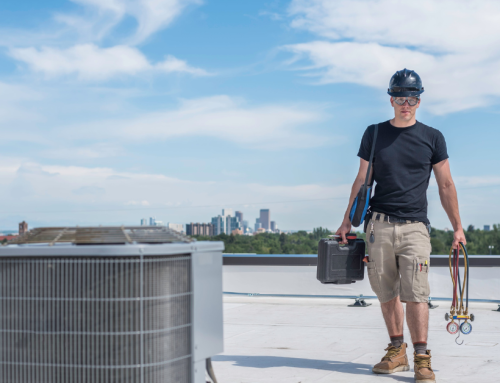In the midst of Denver’s severe winters, which could see up to 60 inches of snow per year, we recommend devoting some care to your HVAC system. After a significant snowfall, an HVAC system may be buried behind a pile of snow, making it difficult to function optimally. Due to the importance of airflow for HVAC systems, keeping a check on them during snowstorms can help avoid breakdowns.
The following is a list of common HVAC problems that our technicians frequently encounter during the winter in Denver. We’ve also included its causes as well as solutions to remedy it.
1. Frozen Pipes
Cause
It’s likely that the evaporator coils in your air conditioner are becoming too cold, causing your A/C line to freeze. Refrigerant is pumped into the system’s evaporator coils, where it removes the heat generated by the air conditioner. During winter, the temperature difference between the inside and outside may become too great, causing your coils to freeze.
Solutions
If you think that the evaporator coils are frozen, turn off your air conditioner immediately. Compressors are expensive pieces of HVAC equipment, and not doing this might lead to their destruction. To put your air conditioner back into cooling mode after being off for a while, just shut off the thermostat, switch on the fan, and wait a while. It may help for a little while, and it would certainly save your compressor from being damaged until you decide what else to do.
The air filter should be cleaned or replaced if it is unclean or hasn’t been cleaned in a while. Not only is it crucial to the health of your air conditioner, but also to the purity of the air in your house. Not sure how to clean or replace yours? No worries! Just contact us for your HVAC maintenance needs today.
You should also always leave the supply and return vents of your air conditioner accessible. If you close the supply vents or the return vents, the airflow over the evaporator might be restricted, which would prevent heat from being transferred.
Note that quick do-it-yourself remedies may help you temporarily unfreeze your refrigerant line, but your system probably will probably still require professional repair to address the underlying source of the issue. Hiring our certified air conditioning technicians in Denver can save you a lot of stress.
2. Uneven Air Flow and Temperature
Cause
Assessing for air leaks around windows and doors is a good first step, but it may not be enough. If your home’s heating, ventilation, and air conditioning (HVAC) ducts and vents are obstructed, the airflow may be uneven and the temperature in different rooms will fluctuate.
Solutions
Common practice calls for unscrewing grills and coverings from ventilation ducts. Next, use paper towels to block up the air intake vents. Afterward, turn the thermostat to the “fan on” setting.
Once the duct is freed from its ducting, it may be removed. Both the supply and return registers need to be cleaned. After a thorough cleaning of the system, normal airflow should be re-established.
If you’ve exhausted every troubleshooting method for the air ducts in your home to no avail, it’s time to call one of our professional HVAC technicians. If you prefer, we can also install a ductless HVAC for you, so you can say goodbye to clogged ducts for good!
3. A Broken Thermostat
Cause
When your thermostat is dirty or out of calibration, it can’t properly regulate your temperatures. The heating system won’t function as intended if the thermostat is broken.
Solutions
Installing a new thermostat in your home’s heating system may seem like a simple heating repair that can help you save money. However, installation and fine-tuning are tasks best left to specialists. Only a trained HVAC professional like our certified HVAC technicians should install your thermostat and test its functions.
4. A Pilot Light That Doesn’t Ignite
Cause
Using a pilot light is necessary for the ignition of older central heating systems. Issues like a dirty flame sensor might be to blame if the pilot light won’t ignite. A flame sensor is an inexpensive part of your heating system that performs an essential function. It’s a thin metal rod with a small curve that sits in front of the pilot light of a furnace.
The gas valve is opened, and gas is pumped into the combustion chamber, where the pilot light ignites the burners when the thermostat signals that it is time for the furnace to come on. As soon as the gas valve is turned on, the flame sensor’s responsibility is to make sure there is a flame present.
Solutions
Turning the furnace off, disconnecting the sensor, cleaning it, and checking it might bring your heating system back up and work. However, if you have any doubts about this procedure or encounter difficulties, it’s best to contact our professional Denver furnace repair technicians.
5. Faulty Heat Pumps
Cause
It’s possible for ice, rain, and snow to impede your heat pump’s operation. These components may prohibit the fan in your heat pump from operating.
Solutions
Either let the ice melt by itself or splash some tepid water over the device to clear the fan of any accumulation. Do not use any kind of tool that might cause damage, such as a shovel or hammer, to try to chip away the ice from your heat pump. If none of these work, please set up a time for one of our heat pump service experts to fix the problem.
Avoid discomfort during the harsh winter months by having your HVAC system checked by our professional HVAC technicians. Contact us today for a quote request for any of the above-mentioned winter HVAC issues.



